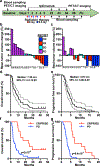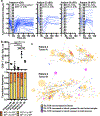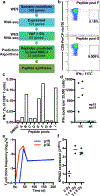Radiotherapy induces responses of lung cancer to CTLA-4 blockade
- PMID: 30397353
- PMCID: PMC6286242
- DOI: 10.1038/s41591-018-0232-2
Radiotherapy induces responses of lung cancer to CTLA-4 blockade
Abstract
Focal radiation therapy enhances systemic responses to anti-CTLA-4 antibodies in preclinical studies and in some patients with melanoma1-3, but its efficacy in inducing systemic responses (abscopal responses) against tumors unresponsive to CTLA-4 blockade remained uncertain. Radiation therapy promotes the activation of anti-tumor T cells, an effect dependent on type I interferon induction in the irradiated tumor4-6. The latter is essential for achieving abscopal responses in murine cancers6. The mechanisms underlying abscopal responses in patients treated with radiation therapy and CTLA-4 blockade remain unclear. Here we report that radiation therapy and CTLA-4 blockade induced systemic anti-tumor T cells in chemo-refractory metastatic non-small-cell lung cancer (NSCLC), where anti-CTLA-4 antibodies had failed to demonstrate significant efficacy alone or in combination with chemotherapy7,8. Objective responses were observed in 18% of enrolled patients, and 31% had disease control. Increased serum interferon-β after radiation and early dynamic changes of blood T cell clones were the strongest response predictors, confirming preclinical mechanistic data. Functional analysis in one responding patient showed the rapid in vivo expansion of CD8 T cells recognizing a neoantigen encoded in a gene upregulated by radiation, supporting the hypothesis that one explanation for the abscopal response is radiation-induced exposure of immunogenic mutations to the immune system.
Conflict of interest statement
Figures




Comment in
-
Radiation promotes systemic responses.Nat Rev Cancer. 2019 Jan;19(1):4-5. doi: 10.1038/s41568-018-0094-4. Nat Rev Cancer. 2019. PMID: 30542079 No abstract available.
-
Radiation promotes systemic responses.Nat Rev Immunol. 2019 Jan;19(1):3. doi: 10.1038/s41577-018-0102-7. Nat Rev Immunol. 2019. PMID: 30546109 No abstract available.
-
Radiotherapy enhances responses of lung cancer to CTLA-4 blockade.J Immunother Cancer. 2019 Mar 6;7(1):64. doi: 10.1186/s40425-019-0542-z. J Immunother Cancer. 2019. PMID: 30841910 Free PMC article.
References
Publication types
MeSH terms
Substances
Grants and funding
LinkOut - more resources
Full Text Sources
Other Literature Sources
Medical
Research Materials

